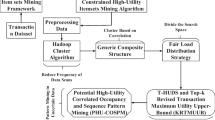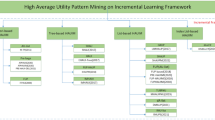Abstract
Utility Itemset Mining (UIM) is a key analysis technique for data which is modeled by the Transactional data model. While improving the computational time and space efficiency of the mining of itemsets is important, it is also critically important to predict future itemsets accurately. In today’s time, when both scientific and business competitive edge is commonly derived from first access to knowledge via advanced predictive ability, this problem becomes increasingly relevant. We established in our most recent work that having prior knowledge of approximate cluster structure of the dataset and using it implicitly in the mining process, can lend itself to accurate prediction of future itemsets. We evaluate the individual strength of each transaction while focusing on itemset prediction, and reshape the transaction utilities based on that. We extend our work by identifying that such reshaping of transaction utilities should be adaptive to the anticipated cluster structure, if there is a specific intended prediction window. We define novel concepts for making such an anticipation and integrate Time Series Forecasting into the evaluation. We perform additional illustrative experiments to demonstrate the application of our improved technique and also discuss future direction for this work.
Access this chapter
Tax calculation will be finalised at checkout
Purchases are for personal use only
Similar content being viewed by others
References
Agrawal, R., Shafer, J.C.: Parallel mining of association rules. IEEE Trans. Knowl. Data Eng. 6, 962–969 (1996)
Agrawal, R., Srikant, R., et al.: Fast algorithms for mining association rules. In: Proceedings of 20th International Conference on Very Large Data Bases, VLDB 1994, vol. 1215, pp. 487–499 (1994)
Ahmed, C.F., Tanbeer, S.K., Jeong, B.-S., Lee, Y.-K.: Efficient tree structures for high utility pattern mining in incremental databases. IEEE Trans. Knowl. Data Eng. 21(12), 1708–1721 (2009)
Alves, R., Rodriguez-Baena, D.S., Aguilar-Ruiz, J.S.: Gene association analysis: a survey of frequent pattern mining from gene expression data. Brief. Bioinform. 11(2), 210–224 (2009)
Andreopoulos, B., An, A., Wang, X., Schroeder, M.: A roadmap of clustering algorithms: finding a match for a biomedical application. Brief. Bioinform. 10(3), 297–314 (2009)
BMSWebView1: SMPF: an open-source data mining library (2016). http://www.philippe-fournier-viger.com/spmf/index.php?link=datasets.php. Accessed 14 June 2016
Brijs, T., Swinnen, G., Vanhoof, K., Wets, G.: Using association rules for product assortment decisions: a case study. In: Knowledge Discovery and Data Mining, pp. 254–260 (1999)
Brin, S., Motwani, R., Ullman, J.D., Tsur, S.: Dynamic itemset counting and implication rules for market basket data. In: ACM SIGMOD Record, vol. 26, pp. 255–264. ACM (1997)
Chan, R.C., Yang, Q., Shen, Y.-D.: Mining high utility itemsets. In: Third IEEE International Conference on Data Mining, ICDM 2003, pp. 19–26. IEEE (2003)
Chen, K., Liu, L.: The “Best k” for entropy-based categorical data clustering (2005)
Guha, S., Rastogi, R., Shim, K.: ROCK: a robust clustering algorithm for categorical attributes. In: Proceedings of 15th International Conference on Data Engineering, pp. 512–521. IEEE (1999)
Han, J., Pei, J., Yin, Y.: Mining frequent patterns without candidate generation. In: ACM SIGMOD Record, vol. 29, pp. 1–12. ACM (2000)
Huang, Z.: Extensions to the k-means algorithm for clustering large data sets with categorical values. Data Min. Knowl. Discov. 2(3), 283–304 (1998)
Lakhawat, P., Mishra, M., Somani, A.: A clustering based prediction scheme for high utility itemsets. In: Proceedings of the 9th International Joint Conference on Knowledge Discovery, Knowledge Engineering and Knowledge Management - Volume 1: KDIR, pp. 123–134. INSTICC, SciTePress (2017)
Lakhawat, P., Mishra, M., Somani, A.K.: A novel clustering algorithm to capture utility information in transactional data. In: KDIR, pp. 456–462 (2016)
Li, H.-F., Huang, H.-Y., Chen, Y.-C., Liu, Y.-J., Lee, S.-Y.: Fast and memory efficient mining of high utility itemsets in data streams. In: Eighth IEEE International Conference on Data Mining, ICDM 2008, pp. 881–886. IEEE (2008)
Liao, S.-H., Chu, P.-H., Hsiao, P.-Y.: Data mining techniques and applications-a decade review from 2000 to 2011. Expert. Syst. Appl. 39(12), 11303–11311 (2012)
Liu, Y., Liao, W.-K., Choudhary, A.: A fast high utility itemsets mining algorithm. In: Proceedings of the 1st International Workshop on Utility-based Data Mining, pp. 90–99. ACM (2005)
Naulaerts, S., et al.: A primer to frequent itemset mining for bioinformatics. Brief. Bioinform. 16(2), 216–231 (2015)
Ngai, E.W., Xiu, L., Chau, D.C.: Application of data mining techniques in customer relationship management: a literature review and classification. Expert. Syst. Appl. 36(2), 2592–2602 (2009)
RetailDataset: Frequent itemset mining dataset repository (2016). http://fimi.ua.ac.be/data/. Accessed 14 June 2016
Seabold, S., Perktold, J.: StatsModels: econometric and statistical modeling with python. In: 9th Python in Science Conference (2010)
Toivonen, H., et al.: Sampling large databases for association rules. VLDB 96, 134–145 (1996)
Tseng, V.S., Wu, C.-W., Fournier-Viger, P., Yu, P.S.: Efficient algorithms for mining the concise and lossless representation of high utility itemsets. IEEE Trans. Knowl. Data Eng. 27(3), 726–739 (2015)
Tseng, V.S., Wu, C.-W., Shie, B.-E., Yu, P.S.: Up-growth: an efficient algorithm for high utility itemset mining. In: Proceedings of the 16th ACM SIGKDD International Conference on Knowledge Discovery and Data Mining, pp. 253–262. ACM (2010)
Yan, H., Chen, K., Liu, L., Yi, Z.: Scale: a scalable framework for efficiently clustering transactional data. Data Min. Knowl. Discov. 20(1), 1–27 (2010)
Zaki, M.J.: Scalable algorithms for association mining. IEEE Trans. Knowl. Data Eng. 12(3), 372–390 (2000)
Acknowledgements
The research reported in this paper is funded in part by Philip and Virginia Sproul Professorship Endowment and Jerry R. Junkins Endowments at Iowa State University. The research computation is supported by the HPC@ISU equipment at Iowa State University, some of which has been purchased through funding provided by NSF under MRI grant number CNS 1229081 and CRI grant number 1205413. Any opinions, findings, and conclusions or recommendations expressed in this material are those of the author(s) and do not necessarily reflect the views of the funding agencies. We also thank Dr. Mayank Mishra, former Post Doctoral Fellow at Iowa State University for his contributions, suggestions and feedback during the intial phase of this work. He was also co-author on the conference paper [14] of which this work is an extension.
Author information
Authors and Affiliations
Corresponding author
Editor information
Editors and Affiliations
Appendix
Appendix

C is the set of all given clusters. A cluster \(C_k \in C\) is essentially a subset of transactions from D.
Cluster utility (CU), relative utility (ru) of a category type in a cluster and the affinity between clusters have the following definitions:
CU is an overall measure of importance of a cluster, since it is the sum of utilities of all transactions in it.
ru is the relative importance (since utility is a unit of importance) given to \(a_i\) among all \(I_{C_k}\) in \(C_k\).
For clusters \(C_i\) and \(C_j\):
It is the sum of shared utility of common category types among two clusters. \(min_{aff}\) and \(min_{uty}\) are tunable parameters of the algorithm. \(min_{aff}\) decides the termination criterion of the clustering and \(min_{uty}\) decides the final selection criterion for the clusters.
Rights and permissions
Copyright information
© 2019 Springer Nature Switzerland AG
About this paper
Cite this paper
Lakhawat, P., Somani, A. (2019). Adaptive Cluster Based Discovery of High Utility Itemsets. In: Fred, A., et al. Knowledge Discovery, Knowledge Engineering and Knowledge Management. IC3K 2017. Communications in Computer and Information Science, vol 976. Springer, Cham. https://doi.org/10.1007/978-3-030-15640-4_8
Download citation
DOI: https://doi.org/10.1007/978-3-030-15640-4_8
Published:
Publisher Name: Springer, Cham
Print ISBN: 978-3-030-15639-8
Online ISBN: 978-3-030-15640-4
eBook Packages: Computer ScienceComputer Science (R0)




